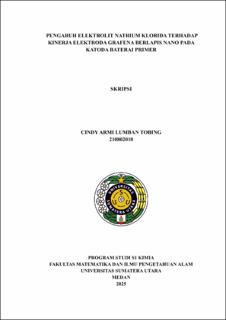| dc.description.abstract | This study aims to investigate the effect of sodium chloride (NaCl) electrolyte concentration on the performance of graphene nanosheet (GBN) electrodes synthesized from candlenut shells as the cathode material in primary batteries. The GBN was synthesized via a two-stage pyrolysis process at 600 °C and 700 °C and characterized using X-Ray Diffraction (XRD) and Scanning Electron Microscopy–Energy Dispersive X-Ray (SEM-EDX). The GBN was then combined with NaCl electrolyte paste in eight concentration variations namely 0,5; 1,0; 1,5; 2,0; 2,5; 3,0; 3,5 and 4,0 M, and its electrical conductivity (DHL), power density, and energy density were analyzed. XRD analysis confirmed the successful synthesis of GBN with a C(002) diffraction peak at 23,2°, while GBN/NaCl samples showed additional peaks at 27,2° (C(002) of NaCl) and 45,5° (C(220)). SEM-EDX revealed that GBN had a multilayer sheet structure with an average particle size of 0,275 µm and a high carbon content of 94,67%. The morphology and particle size distribution of GBN/NaCl varied with NaCl concentration, ranging from 0,17485 µm to 0,27548 µm. The DHL results indicated that the optimum NaCl concentration was 3,0 M, achieving the highest conductivity of 55,06 × 10⁻⁵ S/cm² at 1,5 volts. Lower concentrations yielded limited ion availability, while higher concentrations (>3,0 M) suffered from ion crowding and over-screening effects, reducing ion mobility. The highest power density and energy density were also observed at 3,0 M, with values of 2168,25 W/kg and 61,95 Wh/kg, respectively. Thus, a NaCl concentration of 3.0 M is optimal for enhancing GBN electrode performance, providing a balanced ionic environment, stable electrode morphology, and high energy efficiency in primary battery applications. | en_US |


